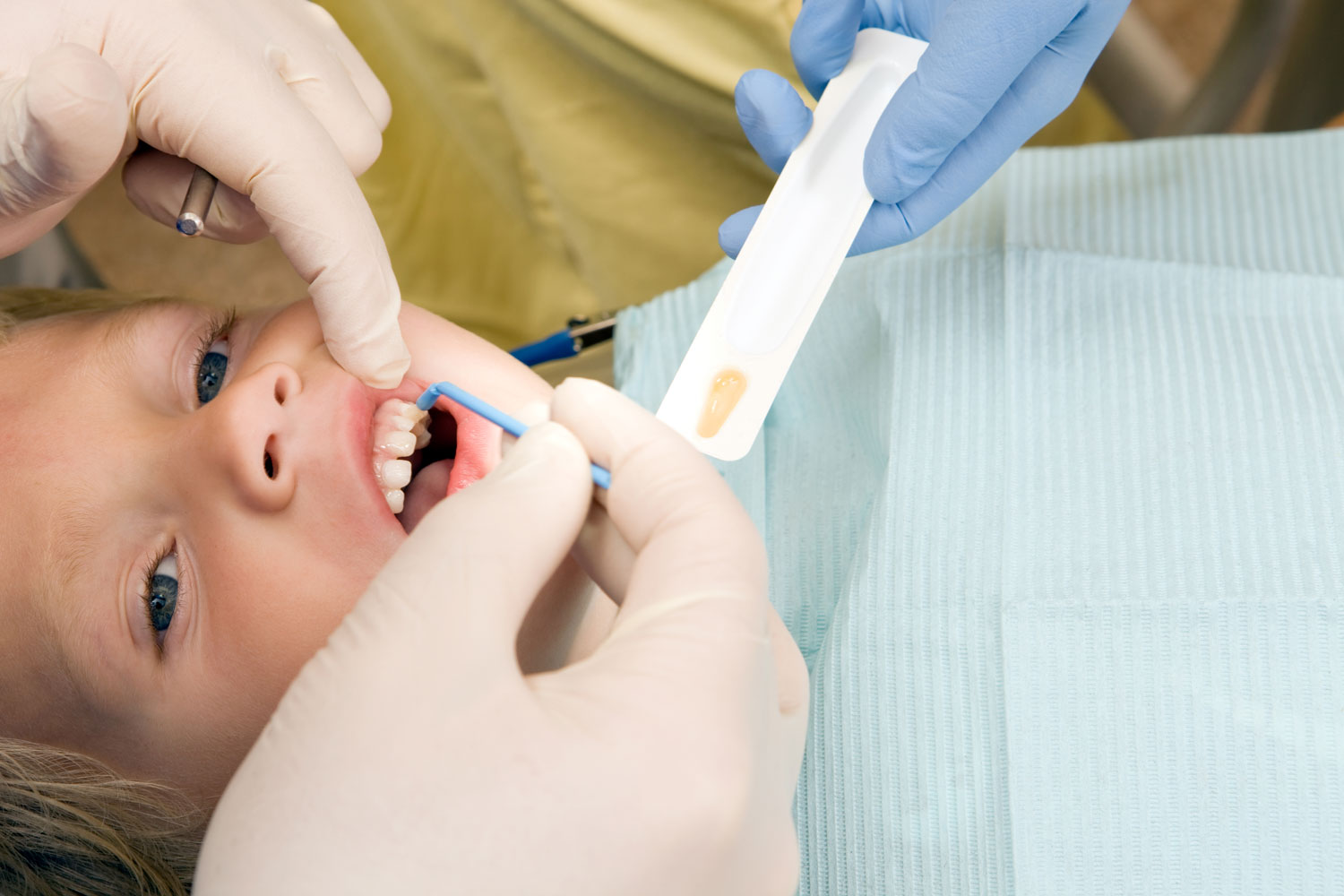Silver Diamine Fluoride
What Is Silver Diamine Fluoride?
Silver diamine fluoride is a product that is painted on areas of active caries (cavities) for the purpose of stopping or arresting the caries. Products like it have been used in Japan for 80 years and in parts of Europe for decades. We are excited to add this option to our treatment for cavities and hope that it will lead to a significant reduction in the number of cavities requiring treatment.
Is Treatment with SDF Painful?
Absolutely not! Since treatment with SDF is non-invasive, there is not typically pain. If the liquid gets on the tongue or lips, there can be a temporary tingling sensation. There is no need for local anesthesia (numbing) or removal of the decay (drilling.) Food debris, if present, is cleaned out, the teeth are gently dried with air, and the SDF solution is applied with a small brush for one minute.
How Does SDF Work?
SDF contains two active ingredients: silver and fluoride. The silver actually kills the bacteria present in caries (cavities.) In addition, the silver ions penetrate the weak part of the tooth and plug up the microscopic holes in the enamel or dentin surface. This residual silver continues to work at killing additional bacteria resulting in tooth structure that can be immune from further decay. The fluoride then helps to remineralize the weak areas of the tooth. One study showed that applying SDF once a year was more effective in stopping cavities than four applications of fluoride varnish four times a year.

What Are the Indications for SDF?
-
For the Very Young Child Who Has Caries (Cavities)
In the past, the only options for treating very young children with cavities were to treat them under duress, under sedation or general anesthesia, or to leave the cavities alone, which usually resulted in worsening of their condition. SDF can now be used to stabilize the cavities until the child is older and can receive treatment without sedation or general anesthesia.
-
For the Special Needs Child
Special needs children often have unmet dental needs. Parents are naturally nervous about how their child will “act” at the dentist, so they avoid even taking their child to the dentist. Cavities in special needs kids can be stabilized with SDF, thus possibly avoiding the need for sedation or general anesthesia.
-
For Children with Cavities in Primary (Baby) Teeth
We weigh many factors when deciding whether cavities in baby teeth need treatment or not. Usually, baby molars are lost around the ages of 10-13. For older kids with moderate-sized cavities, SDF can be used to stabilize the cavities until the teeth are lost. For younger kids with cavities in baby molars. SDF can be used to stabilize cavities and hopefully prevent the need for any treatment at all.
-
For Children with Hypoplasia or Hypomineralization
Sometimes, children have a condition in their enamel called hypoplasia or hypomineralization, in which the enamel does not properly calcify. Causes for this condition can be high fevers or illness when younger, antibiotics, prematurity, genetic, and unknown causes. These teeth can decay quickly and are frequently very sensitive. Teeth with hypomineralization can be very painful to treat, even when proper local anesthetic has been provided. SDF can be used to stop the progression of the decay and to even stabilize the weak enamel. By stabilizing the enamel, it also provides relief from what can be a very painful condition.
-
For the Adolescent with Small Cavities on the Chewing Surfaces or between the Teeth
Although SDF is not as effective for treating cavities between the teeth as it is for treating exposed parts of the teeth, it can stabilize the cavities. Along with changes to diet and hygiene, it is hoped that cavities on the permanent teeth will not progress and will not require treatment. Our goal is to prevent the need for large fillings on kids at such a young age since large fillings can often lead to larger fillings, crowns, root canal treatment, and even tooth loss as a person gets older if the factors that lead to the cavities are not addressed and modified.
-
For Parents Wanting a Conservative Treatment
For the parent who wants to opt for more conservative treatment and minimize the child’s exposure to filling materials, sedation, general anesthesia, and fluoride. Even though SDF does contain fluoride, it is minimal compared with professional topical fluoride and prescription-strength fluoride and only contains the amount of fluoride present in one liter of fluoridated water.

-
Will My Child Not Need Traditional Treatment for Cavities?
Possibly, but there is no guarantee. SDF has been shown to have about an 80% success rate when applied twice per year. 20% of cavities will continue to grow. SDF has been shown to be a little less effective for cavities between the teeth compared to cavities on other surfaces. Along with changes to dietary habits, hygiene, and the use of other “anti-cavity” products, we are hopeful our success rate will exceed 80%!
-
How Safe Is SDF?
SDF has been approved for use by the FDA. Silver nitrate has been successfully used by dentists since the 1800s without reported incidence. The advent of local anesthesia possibly caused a shift away from the use of silver nitrate since teeth with cavities could be treated without pain. SDF has been used in Australia and parts of Europe for decades and in Japan for over 80 years without any reported adverse effects. One drop of SDF is usually sufficient to treat up to five teeth. Within that one drop of SDF, there is roughly the same amount of fluoride as a properly fluoridated liter of water. Another comparison is that the amount of fluoride is approximately 1/10th of the fluoride found in the topical fluoride varnish we use. The amount of silver is also well within safe limits.
-
Is SDF Treatment Covered by Insurance?
We are finding that many insurance companies are not covering treatment with SDF. Hopefully, these companies will soon find that this is a more cost effective treatment than traditional dental treatment. To find out if your insurance company covers SDF you can provide them with code D1354 to see if it is a benefit.
-
This Sounds Too Good to Be True. What Are the Downsides?
There are some downsides. SDF does permanently turn the part of the tooth with decay black. Therefore, it is not indicated for front teeth except in a very young child when we want to try to avoid the need for sedation or general anesthesia. It can also discolor weak or hypomineralized enamel. SDF does not always work and will likely need to be reapplied annually. SDF does not fill in any open cavities and may not prevent the need for treatment. Additionally, not all insurance plans cover the treatment. Although it is not a “silver bullet” that works all the time, we are excited that SDF does give us a more conservative method to treat cavities.